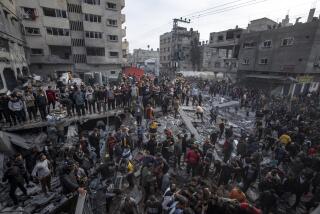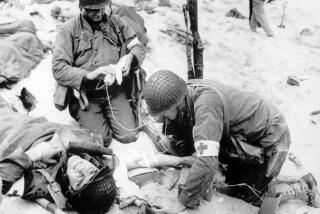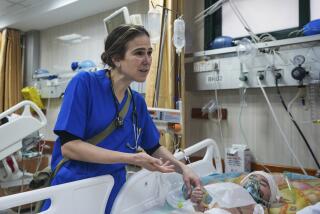Army Doctors Scrambling, Report Says
- Share via
WASHINGTON — A shortage of surgeons to treat the wounded in Iraq has left Army medical teams in the country scrambling to handle the largest number of military casualties since the Vietnam War, the New England Journal of Medicine reports today.
The Army has fewer than 50 general surgeons and 15 orthopedic surgeons in Iraq at any one time to serve more than 138,000 troops. Despite the numbers, advances in battlefield surgical techniques and care mean a greater percentage of soldiers wounded in Iraq are surviving than in any previous American conflict.
The article describes a military medical system that has undergone fundamental changes since the 1991 Persian Gulf War, but that nonetheless has been overwhelmed by the scope and severity of injuries occurring among troops in Iraq. It was written by Atul Gawande, an assistant professor at the Harvard School of Public Health and a former senior health advisor to the Clinton White House.
Since March 2003, 1,276 U.S. military personnel have died in the Iraq war, with an additional 9,765 wounded, according to Pentagon figures. The number of deaths directly related to combat passed 1,000 this week, the Pentagon said.
“Just as the rest of the military structure was unprepared for the length of the war and the evolution in the nature of the war, so has the military medical establishment been understandably unprepared for that,” Gawande said in an interview.
“What is striking is that they have been able to adapt in ways that allow them to keep a high rate of survival for the soldiers,” he said. “But there are costs, and what you see is a potential problem on the horizon.”
Gawande did not specify the number of surgeons he thought the military should have in Iraq. He said there were several indications, though, that the current level was insufficient.
With just 120 general surgeons on active duty, the Army has been forced to use urologists, plastic surgeons and cardiothoracic surgeons to perform general surgery on soldiers in Iraq.
Many surgeons have been deployed for more than two years in the Iraq campaign, and military planners are contemplating pressing some to return, Gawande writes.
The physicians are working under difficult circumstances. In many cases, the military has taken over Iraqi hospitals, and the facilities are flooded with civilian patients whom the Americans are unable to treat. With no clear directive from the Pentagon on treating civilians, some physicians refuse to help even pediatric patients out of fear the children could be booby-trapped with bombs, Gawande writes.
Dr. Michael Kilpatrick, deputy director of deployment health support with the Pentagon’s Office of Health Affairs, acknowledged that Army surgeons working in Iraq had had to improvise in some cases and had been forced to work outside their specialties in others. But he said the relatively low number of deaths proved the system was working.
“There are certainly going to be times in any location where the workload is going to exceed the personnel present,” Kilpatrick said. “There are going to be some extremely long hours at times.”
But, he added, “the fact that they have responded as well as they have speaks to the fact that they were well prepared. You can’t anticipate every eventuality. I think the training and preparation that people had has stood them in good stead.”
Detailing the nature of combat injuries and their complications, Gawande says that blast injuries from suicide bombs and land mines are up substantially in recent months and have proved particularly difficult to treat without risking infection. Eye injuries have caused blindness among a “dismaying” number of soldiers, he says.
Soldiers who survive the initial blasts and field treatment are suffering at high rates from later complications, including pulmonary embolisms (when a blood clot travels to the lungs) and deep venous thrombosis (blood clots in the legs). Some of those soldiers have died of the complications.
Army medical teams are also worried about what Gawande calls an epidemic of multi-drug resistant bacterial infection in military hospitals. Among 442 medical evacuees seen at Walter Reed, 8.4% tested positive, a far higher rate than previously seen among wounded troops.
Despite the challenges, Gawande credits nurses, anesthetists, helicopter pilots, other transport staffers and a rethinking of the combat medicine system for improvements in soldiers’ survival rates.
The system now focuses on damage control, not definitive repair, Gawande writes. Field doctors carry “mini-hospitals” in Humvees and field operating kits in backpacks so they can move with troops and undertake surgery on the spot.
They limit surgery to two hours or less, often leaving temporary closures and even plastic bags over wounds, and send soldiers to one of several combat support hospitals in Iraq.
The strategy seems to be working, Gawande finds. Although at least as many U.S. troops have been wounded in combat in the Iraq war as in the first five years of Vietnam, 90% are surviving, compared with 76% in Vietnam.
Other experts also have credited superior body armor and equipment for improving combat injury survival. But the survivors often have injuries so severe that their future prospects are uncertain, Gawande writes.
One airman lost both legs, his right hand and part of his face. “How he and others like him will be able to live and function remains an open question,” Gawande said.
More to Read
Sign up for Essential California
The most important California stories and recommendations in your inbox every morning.
You may occasionally receive promotional content from the Los Angeles Times.










